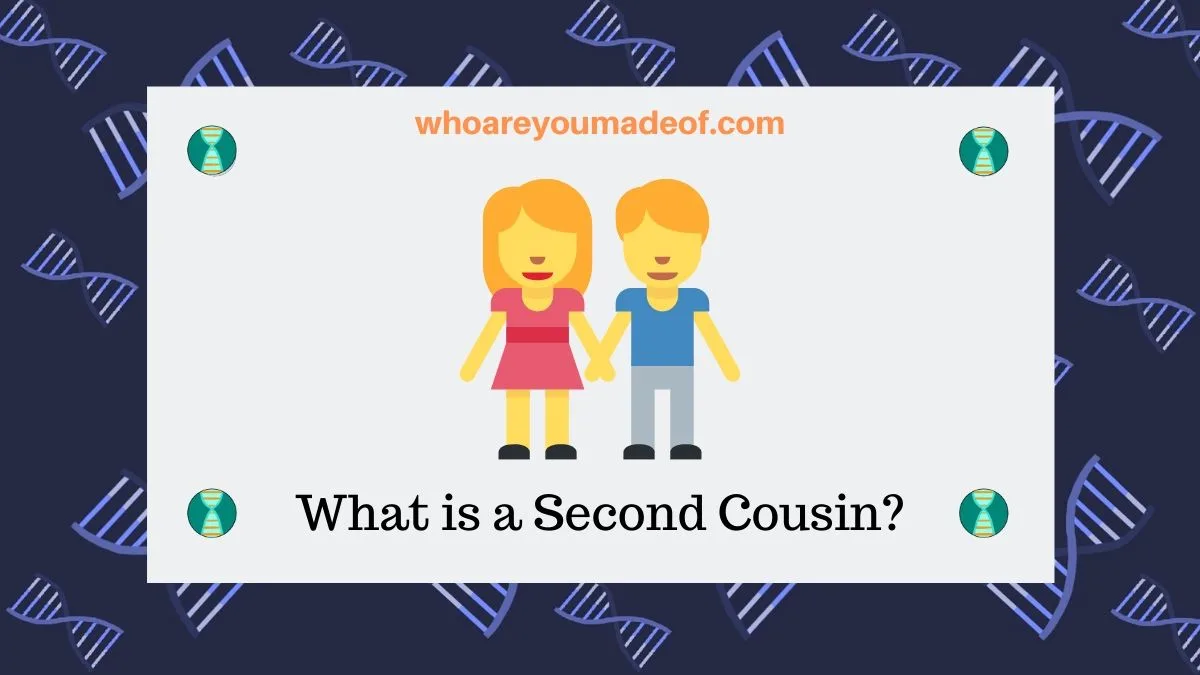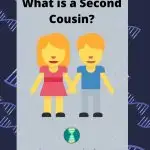What is a second cousin? Our second cousins are actually closely related to us, even if we don't know all of them. In this post, learn all about second cousins!
Some people grow up in a close-knit family and have known their second cousins since they were kids. Others don't know their extended family very well and know they must have second cousins out there in the world somewhere.

My family growing up was somewhere in between. On my paternal grandmother's side of the family, I know my second cousins fairly well. On my mom's side of the family, I never knew her cousins, aunts, or uncles.
Since I have become interested in genealogy and DNA testing, I have learned a lot about my second cousins. When I talk to my relatives about the things I've learned from our second cousins, they ask, "What's a second cousin?"
So, let's get started.
What are second cousins?
Second cousins are people who share great-grandparents and are descended from different offspring of those great-grandparents. In other words, the grandparents of second cousins are siblings.
Another way to understand second cousins is by examining first cousins, which is a relationship that most people are more familiar with. The children of first cousins are second cousins.
First cousins share a grandparents as a common ancestor. The children of first cousins will then share their great-grandparents are their common ancestor.
If you have a first cousin and they have children, and you have children, your children are second cousins to each other. You are also a second cousin to the children of your parents' first cousins.
What's a second cousin once-removed?
If you and your second cousin are not on the same generation, then you are likely second cousins once-removed. The child of second cousin is a second-cousin once-removed.
For example, you are the second cousin once-removed to the second cousins of your mother. Your common ancestor is your great-great grandparent(s), but you are still second cousins, only there is one generation between you.
Thus, you are second cousins once-removed.
The person who is closest to the most recent common ancestor determines the nature of the cousin relationship (i.e. first, second, third cousin, etc). To determine the number of times they are "removed", you just count the number of generations between them.
You have have second cousins three, four, five, six, seven times removed - and more. We will most often find second cousins many times removed when we are doing genealogy research and find relatives of distant ancestors.
How to determine whether someone is your second cousin
If you have a relative that you think might be your second cousin, the first thing you should do is determine who your common ancestor is. Then, figure out who is closest in the number of generations to your common ancestor.
The common ancestor must be a great-grandparent to at least one of you. If the common ancestor is a great-grandparent to both of you, then you are second cousins.
If you find that your common ancestor is a great-grandparent to one of you and a great-great grandparent to both of you, then you are second cousins once-removed.
How many second cousins do we have?
The average person can expect to have about 28 second cousins. Some people will find that they have more, and others less.
The exact number of second cousins will vary from family to family, of course. Factors like the number of children that the great-grandparents had, how many survived to adulthood and produced children, and how many children those children had will affect how many second cousins we have.
Are second cousins considered family?
Yes. Second cousins are considered to be family. In fact, second cousins are generally not even considered to be distant family.
Even though it's legal in every US state to marry your second cousin, this level of cousin relationship is usually known to to be "family". The result of this is that only about .2% of marriages in the US are between second cousins.
That should tell us something about whether second cousins are viewed as family!
Needless to say, second cousins are most definitely not distant cousins. Some people mistakenly believe that they are, but it's simply not true.
Are second cousins blood related?
Second cousins are, indeed, blood related. You will find that you share DNA with all of your second cousins.
We expect second cousins to share an average of 3.13% of DNA with each other, or 233 centimorgans. While this might not seem like much, it's actually fairly substantial when we consider that first cousins can share as little as 7.5% of their DNA.
How to find your second cousins
If you want to find your second cousins, you have three main options. Each option will require a little research on your part, but I promise you that you'll have fun and learn a lot about your family.
Your parents can help you find your second cousins
If you can talk to your parents, this might be the easiest way to find your second cousins. Most of our parents can tell us the full names of their first cousins, or at least their aunts and uncles.
Once you know the names of your parents' aunts and uncles and/or first cousins, you are almost done finding your second cousins. All you have to do is contact your parents' first cousins and explain that you are learning about your family tree.
You can find your second cousins by building your family tree
If you know the names of your great-grandparents, you can locate your second cousins by building your family tree and researching each of your great-grandparents' children and their descendants.
Using this method, you will arrive at your second cousins in just a few generations.
Taking a DNA test can help you find second cousins
If you take a DNA test, like the one offered by Ancestry DNA or 23andMe, you might find many second cousins.
As I mentioned before, your second cousins share DNA with us. This means that if any of your second cousins have taken a DNA test with the same company that you decide to test with, they will show up on your DNA match list as genetic relatives.
To learn more about DNA testing to find living relatives, read this post:
Conclusion
I hope that this post has helped you understand more about second cousins, as well as whether they are considered to be family and how much DNA second cousins share with each other.
If you have any questions about something that you read in this post, or if you would like to share your own experience learning about your second cousins, I would love to hear from you in the discussion below.
Thanks for stopping by today!


Gwen Johnson
Sunday 2nd of February 2025
Okay, who are my mother's first cousins to me? I always thought they would be my second cousins.
Jimmy
Sunday 27th of August 2023
One consideration is regionalism. In the South, where I'm from, it's not unusual for all cousins within a family, whether first, second, or third and so on to be called "cousin" with no differentiation in the closeness of the relationship. Generation isn't a big concern when everyone is called the same thing. You are family or you aren't but that's not always the case especially when a close family friend enters the picture and they've been known for such a long time they are considered a cousin by default. Sometimes, "kin" is used as a substitute for cousin(s), or any family member(s) for that matter, and can be used singularly or plurally. Billy Bob is kin. Billy Bob's family are kin. Try sorting out the different generations and how they are related to one another and it will drive you crazy because that's how Southerners think. You may have to rely on a grandparent or great grandparent to bring some semblance of sanity to the mix but the family Bible may be the final arbiter.
Natalie
Wednesday 8th of June 2022
What does it mean when you should be 1st cousins but DNA shows 2nd cousin's.